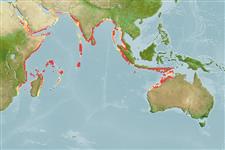Classificatie / Names
Lokale namen | Synoniemen | Catalog of Fishes(Genus, Soort(en)) | ITIS | CoL | WoRMS | Cloffa
>
Eupercaria/misc (Various families in series Eupercaria) >
Lutjanidae (Snappers) > Lutjaninae
Etymology: Lutjanus: Malay, ikan lutjan, name of a fish; indicus: Named for its Indian Ocean distribution..
Environment: milieu / climate zone / depth range / distribution range
Ecologie
marien; zoet water; brak water rifbewoner; diepte 5 - 50 m (Ref. 93093), usually 5 - 15 m (Ref. 93093). Tropical
Indian Ocean: northern continental margin of the Indian Ocean including western Thailand, Myanmar, Andaman Islands, Sri Lanka, India, Gulf of Oman and Arabian Gulf. Western Indian Ocean distribution of L. russellii mentioned in Allen & Talbot, 1985 (Ref. 469) is provisionally referred to as L. indicus; population needs to be reassessed..
Grootte / Gewicht / Leeftijd
Maturity: Lm ? range ? - ? cm
Max length : 22.6 cm SL mannelijk / geslacht onbekend; (Ref. 93093)
Korte beschrijving
Morfologie | Morfometrie
Dorsale stekels (totaal): 10; Dorsale zachte stralen (totaal): 13-14; Anale stekels 3; Anale zachte stralen: 8. This species is distinguished by the following set of characters: D X,13-14 (usually 14); total gill rakers 12-14; body depth 2.5-2.9 in SL; eye 4.2-4.6 in HL; interorbital 5.9-7.0 in HL; the scale rows above the lateral line rise obliquely toward dorsal profile; predorsal scales extending forward nearly to level of rear part of orbit; weakly developed preopercular notch and interopercular knob; upper surface of tongue with central patch of fine granular teeth; vomer with diamond-shaped to narrowly crescent-shaped patch of granular teeth with medial posterior extension; truncate caudal fin; in life it is overall pale grey, grading to silvery white on cheek, opercle, and lower side of body with series of seven dark brown to yellow stripes on posterior head and side, prominent black spot, about 1.2-1.5 size of eye, on posterior back below base of first 6-7 soft dorsal rays, its lowermost part occupying about one scale row below lateral line (Ref. 93093).
This species was observed in coral-reef habitat; generally encountered solitary or in small groups in about 5-15 m depth. It is also taken by trawlers in deeper water (to at least 50 m) and usually appears in fish markets. Few information on juvenile habitat, but suspected to be similar to L. russellii where young are found in brackish mangrove estuaries and lower reaches of freshwater streams (Ref. 93093).
Levenscyclus en paargedrag
Maturiteit | Voortplanting | Paaien | Eieren | Fecunditeit | Larven
Allen, G.R., W.T. White and M.V. Erdmann, 2013. Two new species of snappers (Pisces: Lutjanidae: Lutjanus) from the Indo-West Pacific. J. Ocean Sci. Found. 6:33-51. (Ref. 93093)
Status op de Rode Lijst van het IUCN (Ref. 130435)
Gevaar voor de mens
Harmless
Gebruik door de mens
Meer informatie
Lokale namenSynoniemenMetabolismePredatorenEcotoxicologieVoortplantingMaturiteitPaaienPaaiaggregatiesFecunditeitEierenOntwikkeling van de eieren
Leeftijd/GrootteGroeiLengte-gewichtLengte-lengteLengtefrequentiesMorfometrieMorfologieLarvenLarvale populatiedynamiekRekruteringAbundantieBRUVS
ReferentiesAquacultuurAquacultuurprofielKweeklijnenGeneticaElectrophoresesErfelijkheidZiektesVerwerkingNutrientsMassaconversie
Tools
Speciale rapporten
Download XML
Internetbronnen
Estimates based on models
Preferred temperature (Ref.
123201): 26.8 - 29.3, mean 28.3 °C (based on 684 cells).
Fylogenetische diversiteitsindex (Ref.
82804): PD
50 = 0.5000 [Uniqueness, from 0.5 = low to 2.0 = high].
Bayesian length-weight: a=0.01230 (0.00706 - 0.02143), b=2.94 (2.80 - 3.08), in cm total length, based on LWR estimates for this species & Genus-body shape (Ref.
93245).
Trofisch niveau (Ref.
69278): 3.8 ±0.6 se; based on size and trophs of closest relatives
Weerstandsvermogen (Ref.
120179): Hoog, minimale populatieverdubbelingstijd minder dan 15 maanden (Preliminary K or Fecundity.).
Fishing Vulnerability (Ref.
59153): Low vulnerability (18 of 100).
